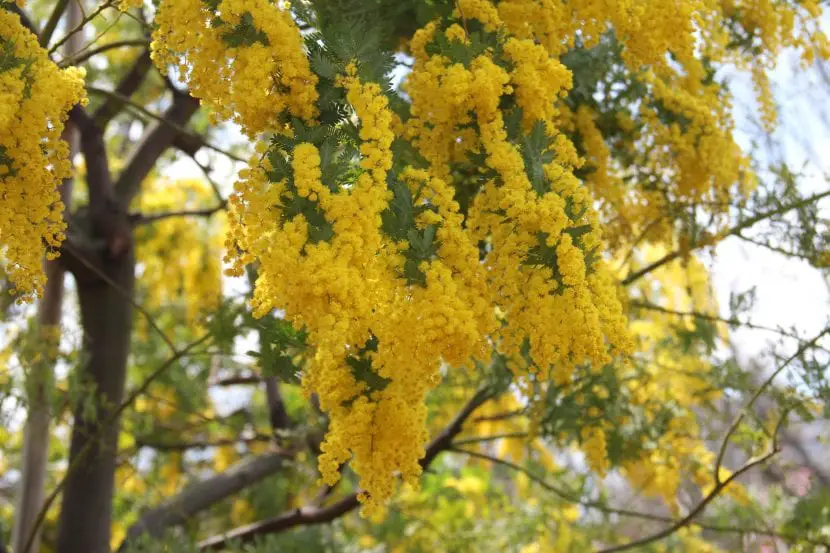
The acacia dealbata It is the most ornamental mimosa, and one of the easiest to care for; in fact, it can be grown in xero-gardens due to its low water requirements. Being fast growing, it will produce nice shade after a very few years, and the best part is that it can be grown in an interesting variety of climates.
But there is still more I want you to know. Details that make this species is one of the best options to decorate the garden. Discover them.
Origin and characteristics of Acacia dealbata

Our protagonist is an evergreen tree native to southeastern Australiaspecifically New South Wales and Victoria. It is known by the common names of mimosa, mimosa acacia, aromo, fine mimosa or Australian acacia, and it is characterized by growing to a height of 10-12 meters. Its foliage is evergreen and consists of bipinnate leaves with about 25-40 pairs of leaflets each, with the upper surface glabrous and the underside tomentose.
Produces flowers in late winter / early spring that are distributed in inflorescences in globose glomeruli (similar to pompons) composed of about 25 very fragrant flowers. The fruit is a bluish-green pod inside which are 4 to 5 rounded seeds.
Your life expectancy does not usually exceed 30 years.
Subspecies
There are two subspecies, which are:
- Acacia dealbata subsp. dealbata: grows at low to moderate altitudes. It lives from low altitudes, and reaches a height of 30 meters.
- Acacia dealbata subsp. subalpine: lives in the Snowy Mountains, and grows between 5 and 10 meters.
How do you take care of yourself?

Do you want to have a specimen in your garden? Here is your care guide:
Location
The acacia dealbata It should be in a bright area, if possible at full sunso that it can grow and develop well.
Soil or substrate
Not demandingbut it will grow best in those that have good drainage. Still, I repeat, we will not have to worry much about this issue, since it is very adaptable and can live well even in slightly limestone soils.
Irrigation
If we have it in a pot, it will be necessary to water it every 3 days in summer and every 7-10 days the rest of the year.. On the contrary, if it is in the garden we will only have to “pamper” it a little every 4-5 days during the first year, and every 10-15 days the following.
Subscriber
It is not necessarybut we can pay it with Organic fertilizers such as egg and banana peels, tea bags, pasty greens, etc. from spring to late fall.
Planting or transplanting time
We can pass it to the garden in springwhen the risk of pulling has passed. In the case of having it in a pot, the we will transplant every 2 years.
Multiplication

It multiplies by seeds in spring, following this step by step:
- The first thing to do is subject them to thermal shock. To do this, we fill a glass with a little water, put it in the microwave for a few seconds (do not let it boil), and then, with the help of a strainer, we introduce the seeds into the water for 1 second. Then, we will introduce them in another glass with water at room temperature for 24 hours.
- The next day, we will see that they have swollen, and some may even have begun to germinate. It will be time to fill a pot with universal growing substrate for plants and place them on the surface of the earth, avoiding putting too many in the same container. Taking into account that they grow very fast, the ideal would be to put 1 in each, or a maximum of 2.
- Then we cover them with a thin layer of substrate and water.
- Finally, we will place the seedbed in a sunny area.
The first little plants will come out after a week.
Pests
If the environment is very humid and hot, it can be attacked by cottony mealybugwhich can be removed with paraffin oil.
Problems
It is very easy to care for, but sometimes problems can arise:
- Yellow leaves, with well visible veins: iron deficiency. It must be corrected with iron chelates.
- Rapid leaf fall: it may be due to excess water. It does not tolerate waterlogging.
- Leaves that fall during or after winter: cold symptom. As long as the temperature does not drop below -6ºC, we will not have to worry; otherwise we must protect it with anti-frost fabric for example.
Pruning
During the fall or late winter (after flowering) we can remove the dry, diseased or weak branches. Likewise, it is advisable to trim those that have grown too much, to about 50-60cm.
Although it is a very resistant tree, you must use pruning tools previously disinfected with pharmacy alcohol.
Rusticity
The Australian mimosa can withstand frosts of up to -6ºC.
What uses does it have?

Ornamental
It is the most beautiful acacia. It is planted in small and large gardens, to provide shade and also to enjoy its beautiful flowers. In addition, it is easy to see it in the streets, parks, promenades, rural houses and public gardens.
Other uses
The gum that exudes its trunk and branches has been used as a substitute for gum arabic due to its high tannin content.
What did you think of acacia dealbata?
